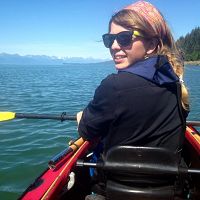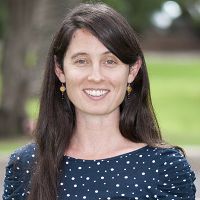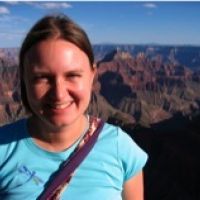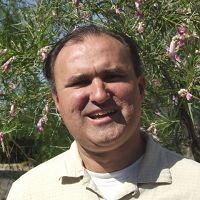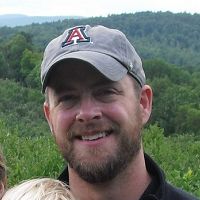Subsurface Biogeochemistry
Subsurface reactions respond to energy, water, and carbon fluctuations that are superimposed on the spatial variability of solids and fluids distributed along water flow paths. Plants play a key transformative role because they convert water and atmospheric CO2 to photosynthate, translating highly-variable radiant energy into a more persistent subsurface reactant enriched in protons and electrons.
Image: Subsurface biogeochemistry (SSB) plays a major role in event-based hydrologic response as well as long-term critical zone evolution. Acids, reducing power, and complexing ligands deriving from the atmosphere and biota react with bases and metals in rock to form regolith and soil.
This group is tagged with:
Biogeochemistry
Soil Science / Pedology
Biology / Ecology
Water Chemistry
-
Organic carbon (C), CO2 and chemical fluxes into and out of the soil zone and into the deeper subsurface represent boundary conditions for geochemical weathering along local and regional flow paths. These weathering reactions affect ecosystem nutrition, subsurface transmissivity, and the poorly quantified surficial to deep inorganic and organic carbon sequestration.
Of particular interest in the SSB theme are the feedback effects between physical and biogeochemical processes. These feedback effects are being probed in the CZ through the use of co-located sensors of soil physical conditions (top) and samplers that are interrogated for time-dependent changes in aqueous biogeochemistry.
Event-based dynamics in soil solution chemistry are coupled to long-term evolution of regolith weathering profiles, with major variation, in this case across multiple CZOs, resulting from climatic variation. Detailed studies of regolith chemistry as a function of parent rock type, climate and depth reveal accumulation and depletion profiles that can then be related to climate and lithological drivers.
References:
Rasmussen C., Brantley S., Richter D.D., Blum A., Dixon J., and White A.F. 2011. Strong climate and tectonic control on plagioclase weathering in granitic terrain. Earth and Planetary Science Letters, 301: 521-530.
Co-location of continuous sensor data as a function of depth (top), with pore water solution samplers (bottom) provides a means to relate subsurface water fluxes with aqueous geochemical response. Data shown are for Pedon 1 (planar hillslope location) in MC ZOB. Soil physical data (top) temperature (T), volumetric water content (VWC), and matric potential (Ψm) are collected continuously for direct correlation with pore water chemistry (bottom), shown here for three depths as time series solution charge balance diagrams.
Soil surface horizon sodium mass transfer coefficient (τNa), a measure of the relative depletion of Na in soil relative to bedrock, for low sloping, ridgetop landscape positions relative to the humidity index defined as mean annual precipitation divided by potential evapotranspiration. The τNa provides a proxy for the chemical loss of plagioclase due to chemical weathering, whereas the humidity index provides a proxy for water availability, with values greater than one indicating water in excess of evapotranspiration and values less than one indicating water limited systems. Sodium depletion tends to increase non-linearly with increasing moisture as represented by the dashed line that is the function: y = y0 + axb, fit between surface tNa and humidity index where y0 = 0.34, a = -0.87 and b = 0.39 (r2 = 0.86). The function was fit excluding the locations with mean annual temperature (MAT) < 5 oC, and locations with physical erosion rate (E) < 20 g m-2 yr-1. These data indicate that both erosion rate and temperature in addition to water availability may also exert significant control on Na loss. Data from Rasmussen et al. (2011).
-
Contacts
-
Catalina-Jemez, INVESTIGATOR
-
Catalina-Jemez, INVESTIGATOR
18 People
INVESTIGATOR
.(JavaScript must be enabled to view this email address)
Univ. of Arizona
Soil Biogeochemistry, Microbial Ecology, Global Change
INVESTIGATOR
.(JavaScript must be enabled to view this email address)
Hydrology, biogeochemistry, terrestrial and aquatic ecosystems
INVESTIGATOR
.(JavaScript must be enabled to view this email address)
Univ. of Arizona
Microbiology, Microbial cultivation, microbial physiology, molecular microbiology, genomics, functio
INVESTIGATOR, Lead-PI
.(JavaScript must be enabled to view this email address)
Univ. of Arizona
Environmental Chemistry and Environmental Biogeochemistry
GRAD STUDENT
.(JavaScript must be enabled to view this email address)
Univ. of Arizona
Environmental Microbiology
INVESTIGATOR
.(JavaScript must be enabled to view this email address)
Univ. of Arizona
Microbial Ecology
STAFF, Field Manager
.(JavaScript must be enabled to view this email address)
Geography, Climatology
.(JavaScript must be enabled to view this email address)
Geochemistry and Soil Sciences
INVESTIGATOR
.(JavaScript must be enabled to view this email address)
Hydrology
INVESTIGATOR
.(JavaScript must be enabled to view this email address)
Hydrology and Biogeochemistry
GRAD STUDENT
.(JavaScript must be enabled to view this email address)
Univ. of Arizona
Geochemistry, Hydrology
Univ. of Arizona
Microbial biogeochemistry, microbial ecology, biogeochemistry
UNDERGRAD
.(JavaScript must be enabled to view this email address)
Univ. of Arizona
Biogeochemistry
Cross-CZO INVESTIGATOR
.(JavaScript must be enabled to view this email address)
UVM
biogeochemistry, Geochemistry/Mineralogy, hydrology
GRAD STUDENT
.(JavaScript must be enabled to view this email address)
Soil, Water and Environmental Science
INVESTIGATOR
.(JavaScript must be enabled to view this email address)
Environmental Physics and Mineralogy
GRAD STUDENT
.(JavaScript must be enabled to view this email address)
Univ. of Arizona
Soil science and digital soil mapping
GRAD STUDENT
.(JavaScript must be enabled to view this email address)
Hydrology
Alumni-Former
GRAD STUDENT
.(JavaScript must be enabled to view this email address)
Geochemistry and Soil Sciences
-
-
Featured Publications
2011
Strong climate and tectonic control on plagioclase weathering in granitic terrain. Rasmussen C., Brantley S., Richter D.D., Blum A., Dixon J., and White A.F. (2011): Earth and Planetary Science Letters, 301(3-4): 521-530,
Explore Further







